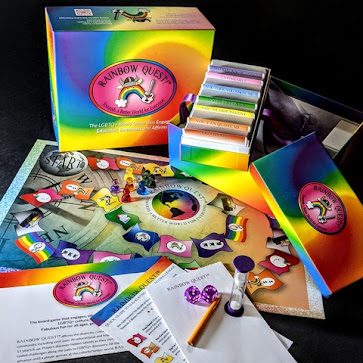Gay Pride Game: Tips for an Engaging and Inclusive Experience
Games are a wonderful way to bring people together, spark joy, and celebrate the LGBTQ+ community during Pride. Whether you’re designing a game for a Pride parade, community event, or private celebration, inclusivity and fun should be at the heart of your creation. Here’s how to design a gay pride game that entertains, educates, and celebrates diversity.
1. Embrace LGBTQ+ Representation
Representation matters, especially in games that celebrate Pride. Make sure your game includes LGBTQ+ symbols, figures, and history to honor the community.
- Incorporate Pride Flags: Use the various pride flags to represent the diversity within the LGBTQ+ spectrum.
- Highlight Icons and Allies: Include references to queer trailblazers, activists, and historical milestones.
- Celebrate Identity: Create characters or avatars that reflect the broad spectrum of gender identities and sexual orientations.
2. Focus on Inclusivity
Your game should be welcoming to everyone, regardless of their background or familiarity with LGBTQ+ culture.
- Keep It Accessible: Use simple instructions and design your game to be played by all age groups and abilities.
- Avoid Stereotypes: Ensure the game doesn’t reinforce harmful stereotypes. Instead, focus on themes of love, acceptance, and individuality.
- Encourage Participation: Design team-based or cooperative challenges that make it easy for everyone to join and feel included.
3. Add Educational Value
Games can be both fun and educational, making them a powerful tool for raising awareness and fostering understanding.
- LGBTQ+ Trivia: Include questions about LGBTQ+ history, rights movements, and important figures to educate players.
- Fun Facts: Share tidbits about Pride celebrations around the world as part of the game.
- Interactive Learning: Incorporate puzzles or challenges that teach players about LGBTQ+ culture while they play.
4. Use Vibrant Visuals
Pride is all about color and expression, so your game design should reflect that energy.
- Rainbow Themes: Use the iconic rainbow as a central design element.
- Eye-Catching Graphics: Incorporate bold colors, glitter effects, and festive illustrations.
- Customizable Elements: Allow players to personalize their experience with customizable characters, flags, or themes.
5. Foster Connection and Joy
A great game brings people together and strengthens bonds.
- Encourage Teamwork: Include cooperative challenges that promote unity and collaboration.
- Create Safe Spaces: Design your game to foster open-mindedness and create a judgment-free zone.
- Celebrate Wins: Reward players with small prizes or recognition to keep spirits high.
6. Test and Iterate
Before launching your game, test it with a diverse group of players to ensure it meets your goals.
- Seek Feedback: Ask for honest opinions about the game’s inclusivity, difficulty, and overall enjoyment.
- Make Adjustments: Use feedback to tweak the design, ensuring it resonates with your audience.
- Ensure Clarity: Double-check that the rules and objectives are easy to understand and follow.
Game Ideas to Inspire You
If you’re unsure where to start, here are a few Pride-themed game ideas:
- Pride Parade Pictionary: Players draw LGBTQ+ symbols, phrases, or scenarios while others guess.
- Queer Quest Adventure: A story-driven game where players navigate challenges to spread love and acceptance.
- Rainbow Race: A relay game with pride-themed obstacles and activities.
- Drag Queen Lip Sync Battle: Combine performance and competition for an unforgettable experience.
Final Thoughts
Designing a gay pride game is a creative way to celebrate diversity, foster connections, and spread joy. By focusing on inclusivity, representation, and education, you can create a game that resonates with players and becomes a cherished part of any Pride celebration.
Let your creativity shine, and remember: games that celebrate Pride are not just about having fun—they’re about honoring love, unity, and the beauty of being true to oneself. 🌈



Comments
Post a Comment